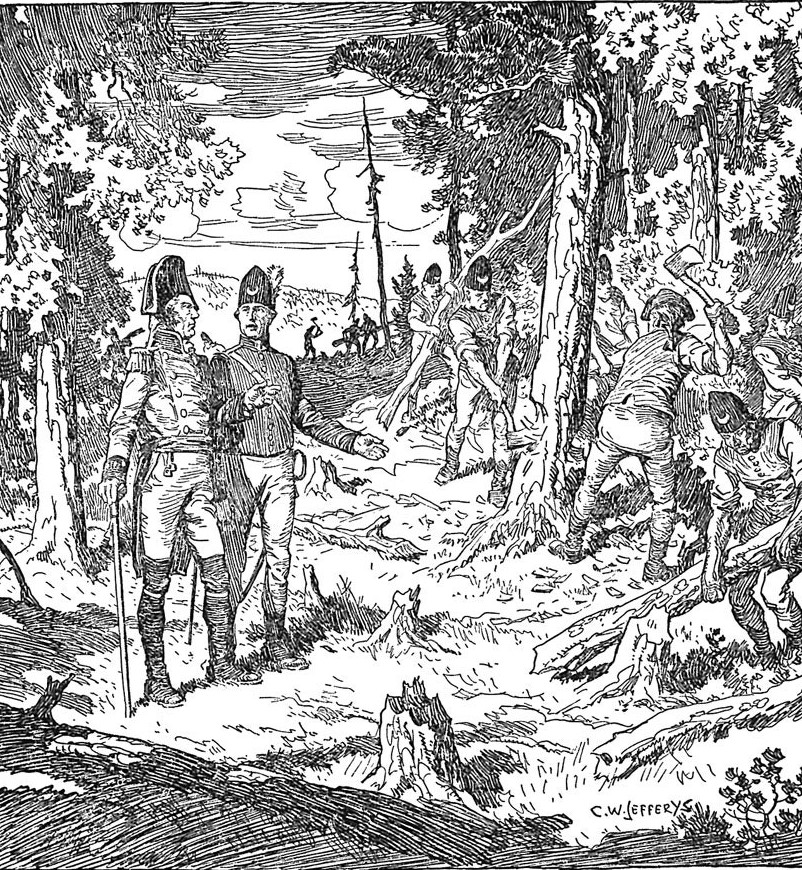
Augustus Jones, the deputy surveyor of Upper Canada, set off in February 1794 to plot the route that would become Yonge Street.
The middle of winter may not seem a particularly astute time to survey a road through unknown bush, but Jones preferred it. The season had actually been a mild one and there was no snow on the ground. The forest floor was frozen hard and there were no leaves on the beech trees to obstruct survey readings.
John Graves Simcoe, the Governor of Upper Canada, wanted Jones to find a 30-mile route to Holland Landing for a military road that would be a shortcut to the upper Great Lakes. The road would provide a land bypass to avoid American-held Detroit. It was going to be called Yonge Street, named for Simcoe’s friend George Yonge, the British Secretary of War. Yonge was also an expert on Roman military roads that were usually called ‘streets’.
It took Jones and his four Queens Rangers about three weeks to lay out the ‘street’. It would have happened faster if they hadn’t done the job twice to make sure it lined up. The Rangers, who cleared small brush out of the way, were Toronto’s original regiment that Simcoe preferred to use for civil projects – about 300 years before Mel Lastman used the military to help dig Toronto out of a snowstorm!
A month later, D.W. Smith, the surveyor-general, directed surveyor Alexander Aitkin to follow Jones’s survey line to create a “road which is to be a chain wide (about 66 feet), lots to 20 chains wide (one-quarter mile) fronting on the road and…containing 200 acres more or less.” Aitkin had been on Simcoe’s original trek the previous fall along the Indian trail that more or less followed the Yonge route.
In all, Aitkin created 111 lots on each side of Yonge, from the 4th Concession (Eglinton) north to Holland Landing. (The three concession roads south of this are now Queen, Bloor and St. Clair.) Each lot was a quarter-mile wide running more than mile east or west of Yonge. The back of the west lots eventually became Bathurst Street, while the east lots ended at what would become Bayview Avenue.
Want to know how big the lots actually were? One still exists. Mount Pleasant Cemetery – from Yonge to Bayview – is about 200 acres.
Aitkin hacked his way through the bush as far as Lot 17 (just south of Mel Lastman Square). It was a road from nowhere to nowhere. Years would pass before Yonge extended south of Eglinton. In the meantime, a rough path meandered east of the present street, eventually joining up with today’s Parliament Street downtown.
The new street through our community was barely passable. Twenty feet wide, it was littered with large tree stumps that had refused to budge. Large potholes created small ponds, swamps had a few logs thrown across, and creeks (like the one where Locke Library now stands) had to be forded.
It may have been inaccessible and rustic, but there was little doubt that when the government began giving away the 200-acre lots, there would be a frenzied interest in acquiring them.
Gary Schlee has been a resident of Bedford Park since 1991. As an author and historian, he has written many articles about the history of our area, notably from 2003 – 2012, for Community Life published by Fairlawn Avenue United Church (FAUC). This article originally appeared in the Fall 2003 issue. BPRO is grateful to Gary and FAUC for kindly and generously authorizing us to reprint these articles on our website. Please come back regularly to see additional articles as we post them.
